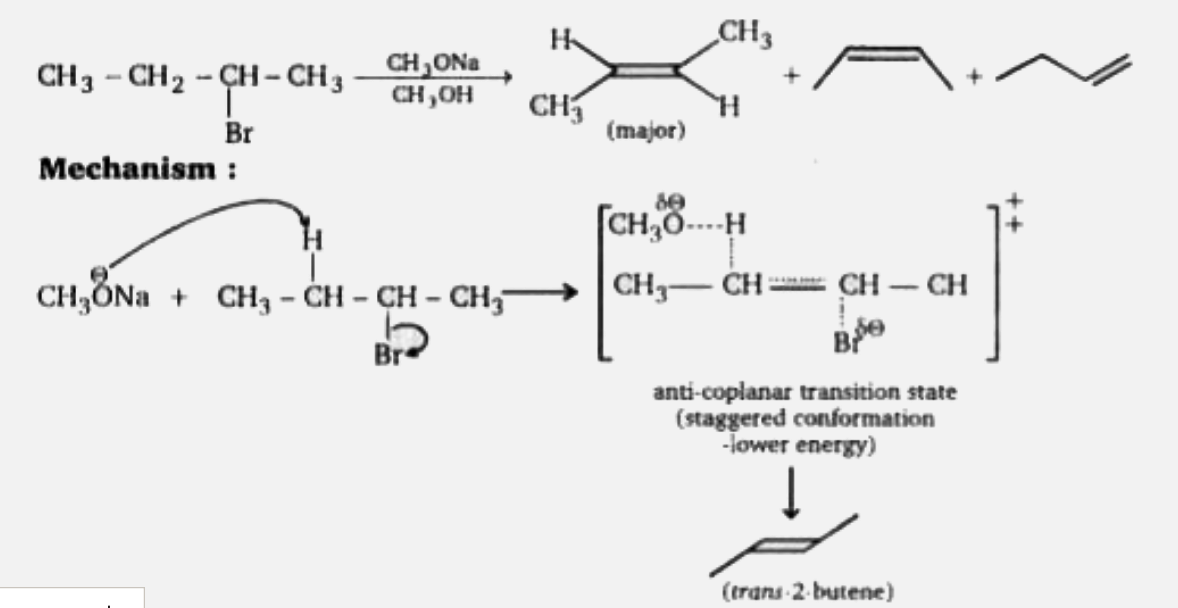Statement - 1 : CH3−CH2−Cl+NalAcetone−−−−→CH3−CH2−I+NaCl⏐⏐↓
Statement- 2 : Acetone is polar-aprotic solvent and solubility order of sodium halides decreases dramatically in order Nal > NaBr > NaCl. The last being virtually insoluble in this solvent and a 1∘ and 2∘ chloro alkane in acetone is completely driven to the side of Iodoalkane by the precipitation reaction. Solution in Kannada
Statement-1 is true, Statement-2 is true and Statement-2 is correct explanation for statement-1.
Statement-1 is true, Statement-2 is true and Statement-2 is Not the correct explanation for statement-1.
Statement-1 is true, Statement-2 is false.
Statement-1 is false, Statement-2 is true.
The correct Answer is:A, C
Acetone is polar aprotic solvent.
Topper's Solved these Questions
- BOOK - MS CHOUHANCHAPTER - ALKYL HALIDES (SUBSTITUTION REACTIONS)EXERCISE - LEVEL-241videos
ALKYL HALIDES (SUBSTITUTION REACTIONS)
- BOOK - MS CHOUHANCHAPTER - ALKYL HALIDES (ELIMINATION REACTION) EXERCISE - LEVEL-225videos
ALKYL HALIDES (ELIMINATION REACTION)
- BOOK - MS CHOUHANCHAPTER - AMINESEXERCISE - Level-21videos
AMINES
Similar Questions
Statement - 1 : Nucleophilicity order in polar-protic solvent is I−<Br−<Cl−<F−
Statement-2 : Due to bigger size of I it is less solvated in polar-protic solvent.02:26View SolutionComprehension
E2 raction → Elimination bimolecular
In the general mechanism of the E2 reaction a strong base abstract a proton on a carbon atom adjacent to the one of the leaving group. As the abstracts a proton , a double bond forms and the leaving group leaves.

Identify the rate of reaction of given compounds in E2 reaction:
 04:17View Solution
04:17View SolutionFive amine syntheses are outlined below. In each reaction box enter a single letter designating the best reagent and conditions selected from the list at the bottom of the page.

 01:44View Solution
01:44View SolutionRank the following species in order of decreasing nucleophilicity in a polar protic solvent ("most"to" least nucleophilic"): (I) CH_(3)CH_(2)CH_(2)O^(-) " " (II) CH_(3)CH_(2)CH_(2)S^(-) (III) " "CH_(3)CH_(2)overset(O)overset(||)C-O^(-)
04:05View Solutionstatement -1 : CH_(3)-CH_(2)-Cl+Nal overset("Acetone")toCH_(3)-CH_(2)-I +NaCldarr statement -2 Actone is polar Nal gt NaBr gt Na Cl the last being virtully insoluble in this dsolvent and a 1^(@) and 2^(@) chlro alkane in actone is competely driven to the side of odoalkane by the precipition reaction reaction .
02:19View Solution(CH_(3))_(2)CHCl+NaI overset("Acetone")rarr (CH_(3))_(2)CHI+NaCl The above reaction is known as :
04:03View SolutionArrange the following halides in the decreasing order of S_(N^(1)) reactivity : underset((I))(CH_(3)CH_(2)CH_(2)Cl), underset((II)) (CH_(2)=CHCH(Cl)CH_(3)), underset((III))(CH_(3)CH_(2)CH(Cl)CH_(3))
04:26View SolutionArrange the following species in order of decreasing nucleophilicity in a polar protic solvent.
(I). CH3CH2CH2O−,
(II). CH3CH2CH2S−
(III). CH3−CH2−O∣∣C−¯¯¯O01:42View Solutionअभिक्रिया R - CH_(2) - Cl + Nal underset(Delta)overset("ऐसीटोन")rarr R - CH_(2)I + NaCl, को कहते हैं -
03:41View SolutionName the following reaction: CH_(3)CH_(2)Cl+Nal overset("Dry Acetone ") to CH_(3)CH_(2)I+NaCl
View SolutionCH_(3)Cl + NaI overset("Dry acetone")rarr CH_(3)I + NaCl . Name the above reaction.
11:03View SolutionWrite the structure of the major product and IUPAC name in each of the following reactions :
(i) CH3CH2CH2Cl+NaIAcetone−−−−→Heat (ii) CH3CH2Cl+SbF3Heat−−→
(iii) CH3CH2CH2OH+SOCI2→ (iv) CH3CH2CH=CH2+HBrPeroxide−−−−→
(v) CH3CH2C∣CH3=CH2+HBrNo Peroxide−−−−−−→ (vi) CH3CH2CH2Br+Hg2F2→
(vii) CH3CH2C≡CH+HCl(1-equiv)→ (viii) CH3CH=CH2+Cl2773−873k−−−−−→View SolutionAssertion: Alkyl iodide can be prepared by treating alkyl chloride/bromide with Nal in acetone.
Reason : NaCl and NaBr are soluble in acetone but Nal is not.View SolutionWrite the structure of the major product and IUPAC name in each of the following reactions :
(i) CH3CH2CH2Cl+NaIAcetone−−−−→Heat
(ii) CH3CH2Cl+SbF3Heat−−→
(iii) CH3CH2CH2OH+SOCl2→
(iv) CH3CH2CH=CH2+HBrPeroxide−−−−→
(v) CH3CH2C∣CH3=CH2+HBrNo Peroxide−−−−−−→
(vi) CH3CH2CH2Br+Hg2F2→
(vii) CH3CH2C≡CH+HCl(1-equiv)→
(viii) CH3CH=CH2+Cl2773−873k−−−−−→01:59View SolutionComplete the following reactions : (i) CH_(3)-CH_(2)-CH_(2)-OH+ SOCl_(2) to (ii) CH_(3)-CH_(2)-CH= CH_(2)+HBr overset("Peroxide")to (iii) CH_(3) - CH_(2)- CH_(2)- Cl+ Nal underset("Heat")overset("Acetone")to
02:01View SolutionWrite the structure of the major organic product in each of the following reaction :
CH3CH2CH2Cl+NaIacetone−−−→heat02:25View Solution
